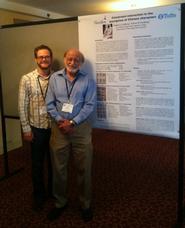
Associate Professor of Art History Stephen J. Goldberg presented a poster titled “Constraint interaction in the inscription of Chinese characters” on July 20 at the 33rd Annual Cognitive Science Conference in Boston. The poster was co-presented with his son Ariel Goldberg, assistant professor of psychology at Tufts University, during a workshop on “Optimality Theory as a General Cognitive Architecture.”
According to Stephen Goldberg, the field of art history has traditionally treated its object of study—art, in its various physical manifestations—as a phenomenon “out in the world.” Art historical descriptions typically employ concepts such as style, genre and historical context which are given explanatory power and are generally assumed to have an existence independent of the artist. And yet art, like language, is fundamentally a product of the human mind. In their poster, the Goldberg’s argued that the field of art history—like linguistics—can benefit from a mentalist perspective and that art should be considered the product of artistic/esthetic cognition.
The goal of the Goldbergs’ research was to formalize the structure of Chinese calligraphic inscriptions in order to better understand human creativity in the art of Chinese calligraphy. They argued that calligraphic scripts can be described in terms of ranked violable constraints that account for the regularities of well-formedness at three levels of calligraphic organization: individual characters (jiegou), component brushstrokes (bifa) and overall compositional arrangement (zhangfa).
In their work they considered three basic calligraphic scripts – seal, clerical and regular script – and they proposed that the calligraphic well-formedness of a particular script can be encoded by Maximum-Entopy (Max-Ent) grammars (Hayes & Wilson, 2008). Max-Ent grammars utilize weighted constraints to assign probabilities to surface forms. All of the constraints in the Goldbergs’ model are Optimality Theory (OT)-style markedness constraints (Prince & Smolensky 1993/2004).
The Goldbergs say their ultimate goal in putting forth this theory is to make the shift to a cognitive perspective in the field of art history by investigating the explanatory force of a constraint-based analysis of the surface forms of Chinese calligraphic inscriptions.
Posted July 30, 2011
